
94% of researchers rate our articles as excellent or good
Learn more about the work of our research integrity team to safeguard the quality of each article we publish.
Find out more
ORIGINAL RESEARCH article
Front. Environ. Sci., 10 August 2023
Sec. Water and Wastewater Management
Volume 11 - 2023 | https://doi.org/10.3389/fenvs.2023.1212552
This article is part of the Research TopicAnticipating and Adapting to the Impacts of Climate Change on Low Elevation Coastal Zone (LECZ) CommunitiesView all 8 articles
The 10 Small Island Developing States (SIDS) of the Caribbean in this study have unsustainable water-energy-food Nexus conditions, with stress becoming more acute via climate change, population demographics and increasing tourist demands. Water resources are limited, and wastewater treatment is inadequate or missing. Nature-based solutions (NBS), especially constructed wetlands, are effective treatment options for all SIDS and have added value for recreation, conservation and product development. On islands with abundant rainfall, NBS treated water adds little to total water resources, but can be important for small scale agriculture. Rainwater harvesting is an important alternative water source for individual households and small communities, but water reuse from tourist infrastructure has the greatest potential for SIDS to reach water sustainability, while protecting coastal waters from sewage pollution. Tourism is a two-edged sword. It swells populations and associated water demand significantly and can degrade coastal waters if wastes are not treated effectively. However, a partnership among the tourist industry, local communities and national government must be given top priority to ensure sustainability of the Water-Energy-Food (WEF) Nexus in the face of progressively increasing tourist numbers and pressures. Effective governance is needed at the island and regional level to develop sound adaptative management approaches for sustainability.
Of the 58 Small Island Developing States (SIDS) recognized by the United Nations in 1992 for their unique social, environmental and development issues, the vast majority are in the Pacific (67%) and Caribbean (25%) basins (United Nations, 1993; UNCTAD, 2021). Shared features include remoteness, limited natural resources, fragile environments, susceptibility to natural disasters, and excessive dependence on international trade. Their small but increasing populations tend to be concentrated in coastal areas <5 m above mean sea level (SIDS average 30% of population) (UN-OHRLLS, 2013).
Interactions among the three major components of sustainability (water, energy, food) are conveniently conceptualized via the WEF nexus. Castillo and Crisman (2019) envisioned the nexus as a wheel, whose spokes are water, energy and food that join at the hub (health) and whose rim is economics. Economics is the overall control over the resources and their interactions, and imbalances in inter sector relationships can adversely affect human health. Application of the nexus approach to 10 Caribbean SIDS (Winters et al., 2022) and Puerto Rico (Crisman et al., 2021) concluded that none of the islands are sustainable. While infrastructure and governance are either unable to address requirements of the nexus under current or projected conditions, local communities and the natural environment are amazingly resilient even when devastated by natural disasters (Crisman et al., 2022) (Figure 1).
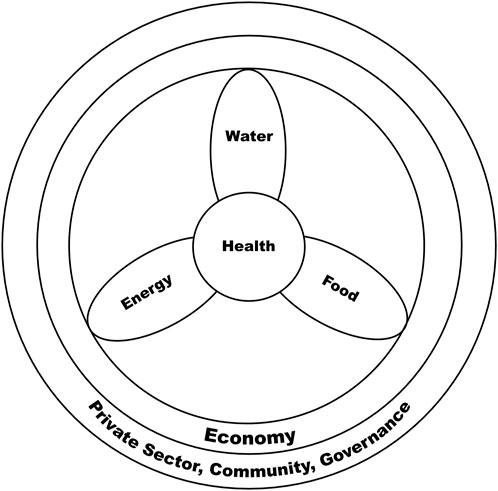
FIGURE 1. WEF nexus model. Adapted from Crisman et al. (2022).
Although Castillo and Crisman (2019) recognized the negative impacts of the nexus on human and environmental health, most nexus research has largely focused on quantitative aspects of each component while ignoring quality issues. Water resources in Caribbean SIDS are increasingly taxed by expanding population demands, projected reduced precipitation associated with climate change and losses to evapotranspiration (Jordan and Fisher, 1977; Gohar and Cashman, 2017; IPCC, 2022). Watersheds tend to be small and steep, thus magnifying nutrient and pollutant discharges from human sources (ECLAC, 2000; Winters et al., 2022). Impacts to coastal marine areas including reefs (the principal fishing area) and beaches, where recent infestations of seaweed (Langin, 2018), have added to economic damage to the tourist industry contributed by fecal contamination (Siung-Chang, 1997; Sutherland et al., 2010; Ali et al., 2018; Compton and Forde, 2020).
Infrastructure for wastewater treatment is either mostly antiquated or non-existent, and few Caribbean SIDS have resources to improve the situation. Islands can never become sustainable as long as environmental impacts from the WEF nexus exceed balanced conditions and maximum efficiency of the nexus. In keeping with the spirit of the nexus, nature-based solutions (NBS) to waste management are the best option of Caribbean SIDS but their implementation has languished (Castillo and Crisman, 2019; Rodriguez-Dominguez et al., 2020). As demonstrated globally (Masi et al., 2010; Gorgoglione and Torretta, 2018), constructed wetlands are inexpensive and highly effective treatment alternatives for traditionally engineered infrastructure and have the added benefit of contributing nexus sustainability via water reuse for domestic and agricultural purposes, product development for the local economy and nature conservation (Mycoo et al., 2015; Peters, 2015; Corbi et al., 2021; Valero et al., 2021; Carvalho et al., 2022).
The current study revisited the 10 Caribbean SIDS for which current and projected WEF nexus sustainability was based on water quantity (Winters et al., 2022) to evaluate nexus impacts on water quality and whether these could be reduced by implementation of NBS wastewater treatment systems. Scenarios considered both human and climate projected future impacts. Particular emphasis was placed on the potential for treated water to supplement local water resources and community stability.
Ten of the 16 Caribbean SIDS were selected for this study based on data availability. Countries spanned the Caribbean basin and included: Antigua and Barbuda, the Bahamas, Barbados, Dominica, Grenada, Jamaica, St. Kitts and Nevis, St. Lucia, St. Vincent and the Grenadines, and Trinidad and Tobago (Figure 2). Demographic and physical characteristics of islands were compiled. Most countries had a population of under 1 million; however, populations ranged from around 53,000 (St. Kitts and Nevis) to 3 million (Jamaica). GDP values varied from nearly $546,000,000 (Dominica) to approximately $21 billion (Trinidad and Tobago). Surface area ranged from 260 km2 (St. Kitts and Nevis) to nearly 14,000 km2 (Bahamas) and agricultural area from 60 km2 (St. Kitts and Nevis) to 4,540 km2 (Jamaica) (Table 1).
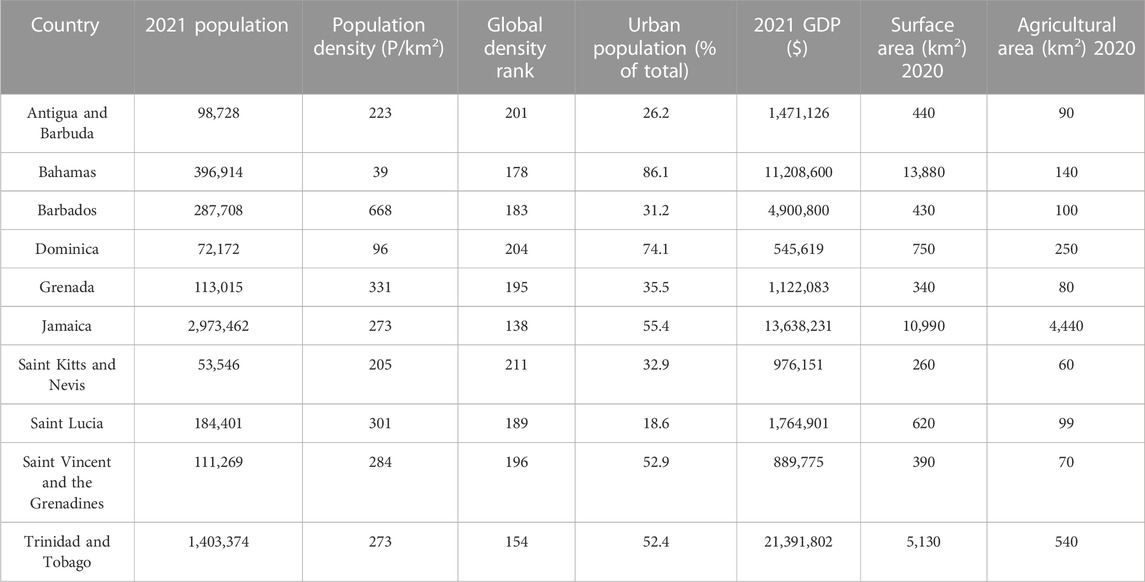
TABLE 1. Demographic and physical characteristics of Caribbean SIDS used in analyses. Data obtained from the World Bank (https://data.worldbank.org/) and Worldometer (https://www.worldometers.info/world-population/caribbean-population/).
Four GIS layers were utilized to evaluate parameters critical for evaluating potential NBS sites for each SIDS (Table 2). From the LULC shapefile, “open areas” were extracted from the following land cover classes in the Copernicus Global Land Operations product use manual (https://land.copernicus.eu/global/sites/cgls.vito.be/files/products/CGLOPS1_PUM_LC100m-V3_I3.4.pdf): shrubs, herbaceous vegetation, bare/sparse vegetation, permanent water bodies and herbaceous wetland. “Open areas” were used as the land use parameter for finding suitable sites for NBS, with a focus on constructed treatment wetlands.
Clipped elevation data were used to develop slope shapefiles for each island. Slopes less than or equal to 26° were selected as the slope parameter for locating suitable sites for NBS. Typical constructed wetland design requires slopes less than 26.6° (2:1 ratio of horizontal to vertical distance) (Davis, 1995; Crisman et al., 2021).
Areas with population density at or greater than each country’s 75th percentile of population density were extracted, as major cities across the Caribbean were within the 75th percentile of population density. A 1.6 km (1.0 mile) buffer was then created around these areas to serve as “High Population Areas”, which was the population parameter for locating suitable sites for NBS. The intersects of “open areas”, slopes at or under 26°, and “high population areas” were located, creating a shapefile of suitable sites across each country.
Each island was then evaluated to determine if potential sites were sufficient for implementation of NBS to support a stable WEF Nexus. Kadlac and Wallace (2009) suggested constructing wetlands for wastewater treatment with a ratio of 1 km2 of wetland to treat 12,500 m3/day, assuming wastewater production of 0.379 m3/person/day. Using these metrics, each country’s population was multiplied by the projected amount of wastewater per person to determine the total wastewater produced for each country daily. This value was divided by the ratio of 1 km2 to 12,500 m3/day to determine the amount of land area each country would need to convert to constructed wetland to treat their wastewater. Wastewater reuse was then reduced by 70% as a conservative estimate of water lost from wetlands via evapotranspiration (Bidlake et al., 1996; Jacobs et al., 2004; Exner-Kittridge and Rains, 2010).
To understand how sustainability classifications might change over time with increasing climate change impacts, water availability as a function of population growth and modeled sea level rise was calculated for each country. Population was modeled using current population growth estimates from the World Bank (https://data.worldbank.org/) and combined with precipitation rate changes (Hall et al., 2013) to calculate water use through 2,100. Sea level rise was modeled based on the RCP 8.5 (Representative Concentration Pathway; warming of an average 8.5 W per square meter globally), which estimates that sea level rise will vary between 0.3 and 1.35 m in the Caribbean by 2100 (Strauss and Kulp, 2018). Sea level rise shapefiles were added to potential site shapefiles to determine if potential site locations would remain above water by the year 2100, based on sea level rise projections.
With the exception of Jamaica, Trinidad and Tobago and Barbados, populations of the Caribbean SIDS are relatively low, with most below 200,000 (Figure 3). The populations of two SIDS (Antigua and Barbuda, Bahamas) are expected to double potentially by 2021, but those of the other SIDS will increase only moderately (mean 1.3 times) (https://data.worldbank.org/). Population projections are complicated by both migration trends and tourism. Although low when considered globally, all but three of the SIDS of this study displayed major populations emigration. The impact of tourism on island WEF nexus sustainability is complicated by seasonal influx of visitors tending to consume resources at higher rates than resident populations.
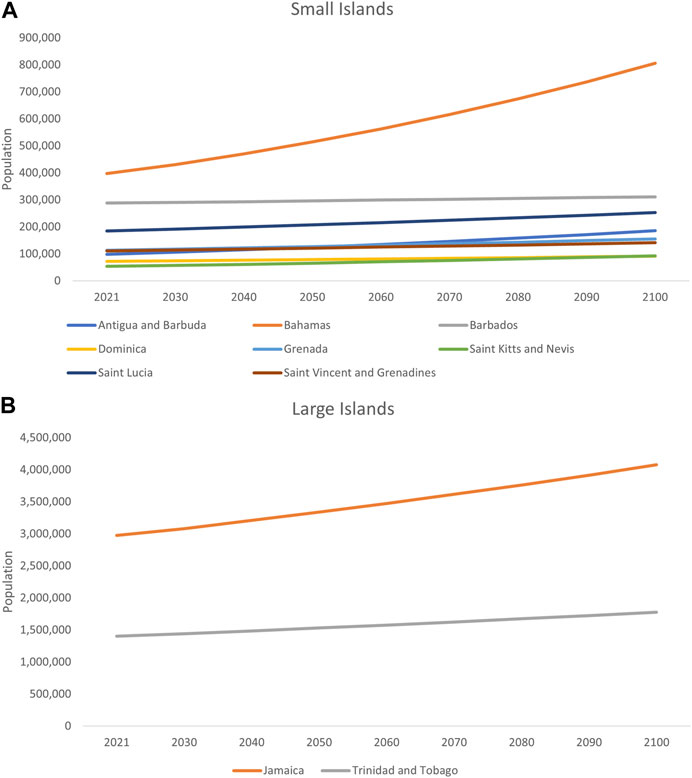
FIGURE 3. (A) Small island population growth through 2100. Figure 3 (B) Large island population growth through 2100. Data from the World Bank Database.
Population densities of the SIDS ranged from 39 to 668 persons/km2, values representative of moderately dense nations globally (Table 1). The percent of the population considered urban was highest in Bahamas (86%) and Dominica (74%) but was considered low for the remainder of the study SIDS.
Water availability per capita (m3/capita/year) for each SIDS in 2020 and projections to 2100 (Figure 4) were based on resource estimates from the FAO AQUASTAT database (FAO, 2020) and population estimates (World Bank (https://data.worldbank.org/) and Worldometer (https://www.worldometers.info/world-population/caribbean-population/). Falkenmark Water Stress Indicators (Falkenmark, 1989) were calculated for each SIDS for 2020 and projected to 2100. Per capita values for water security categories are: Water stress (<1,700 m3/capita/year), Water Scarcity (<1,000 m3/capita/year), and Absolute Water Scarcity (<500 m3/capita/year). Water stress, the indicator selected for this study, means that a nation is not meeting water thresholds regularly for agricultural, domestic and industrial purposes.
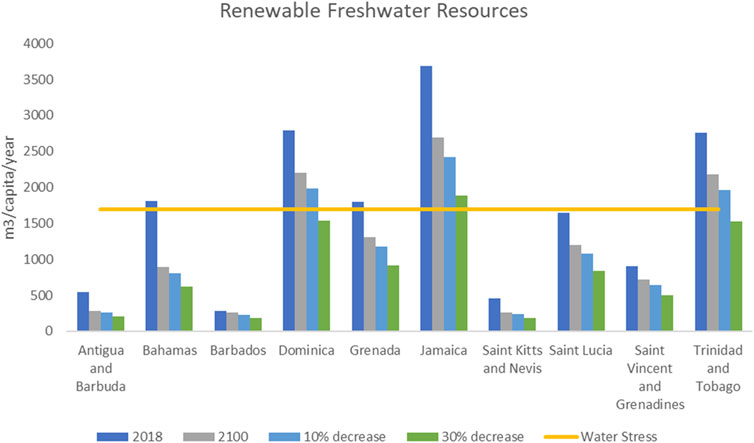
FIGURE 4. Current and projected changes in renewable water resources from 2018 to 2100. Data from World Bank Database.
Five nations were considered water secure in 2020, two of which were marginally above the water stress level for the Falkenmark indicator (Figure 4). By 2100 these marginal nations are expected to have lost water security. Antigua and Barbuda, Barbados and St. Kitts and Nevis are currently experiencing Absolute Water Scarcity (<500 m3/capita/year), with the situation becoming dire by 2100.
Although impacts will not be uniform throughout the basin, the Caribbean SIDS are expected to experience significant sea level rise, increased temperature and reduce rainfall by 2100 (Portner et al., 2022). The Greater Antilles are projected to see temperatures increasing 1°C to 5°C annually (Cashman et al., 2010) and 10%–30% reduction in precipitation (Hall et al., 2013). Climate change impacts on water resources for our Caribbean SIDS associated with scenarios of 10% and 30% precipitation reduction were combined with population related resource projections to 2100 (Figure 4). Dominica and the two largest islands of our study (Jamaica and Trinidad and Tobago) will retain water security with a 10% reduction of precipitation by 2100, but Jamaica will be the only SIDS under a rainfall reduction of 30%.
With the exception of the two largest islands, the resident populations of SIDS of this study each generated less than 200,000 m3/day reflecting their relatively low populations (Figure 5). These data, however, do not consider the shift in local economies to favor tourist infrastructure and its impact on human populations. The flux of tourists to the SIDS is both seasonal and relatively short term, but many islands are encouraging retirement communities, which would add to year-round stress on water resources. Annual numbers of short-term tourists vary greatly among SIDS (Table 3), ranging from a minor impact on population levels (Trinidad and Tobago, Jamaica) to significantly elevated human pressures (10–20 times) on local water resources and wastewater generation (Antigua and Barbuda, Bahamas, St Kitts and Nevis). Tourists tend to consume more water per capita than local populations and generate larger volumes of wastewater (UNEP, 1999). SIDS with the largest ratio of tourists to resident populations are also either showing absolute water insecurity or water stress currently. This study did not address the extent that tourist infrastructure is integrated with local water resources and waste treatment.

FIGURE 5. Wastewater production for each SIDS in this study. Population data were multiplied by the wastewater production rate of 0.379 m3/capita/day. Data was compiled from the World Bank Database and Kadlec and Wallace (2009).
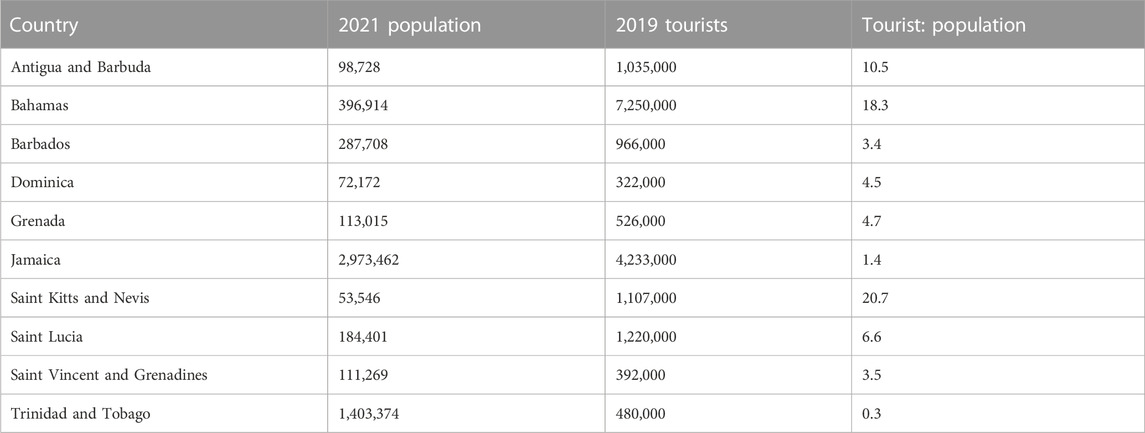
TABLE 3. Comparison of annual tourist numbers with resident populations of each SIDS of this study. The tourist:population ratio is how many times the local population is increased by tourists.
Wastewater treatment in the Caribbean SIDS is woefully inadequate to meet current population needs (Table 4). Only two SIDS have urban populations exceeding 60% (Table 1), and centralized treatment systems are not practical due to widely dispersed populations and steep terrain on many islands. If existing, treatment is at the household level and mainly pit latrines and septic tanks. Steep slopes and proximity to streams hinder effective treatment.
Nature-based solutions for wastewater treatment, including constructed wetlands, provide comparable treatment efficiency as grey infrastructure at a fraction of the cost (Castillo and Crisman, 2019). Their use in Latin America is gaining rapid acceptance, but only to a limited extent in Caribbean SIDS. Available open areas (minus forests) were determined for each SIDS and evaluated as potential treatment options for current and projected (2100) populations and associated waste generation (Figure 6). Dominica, Grenada and St. Vincent and the Grenadines lack sufficient open space for constructed wetlands to be an effective option, while the remainder of SIDS currently have sufficient open space to treat current and projected waste loads. Applicability in St. Lucia, however, is questionable beyond 2100. The assessment did not include the impact of tourists on waste loads, which could overwhelm wetland treatment in most SIDS.
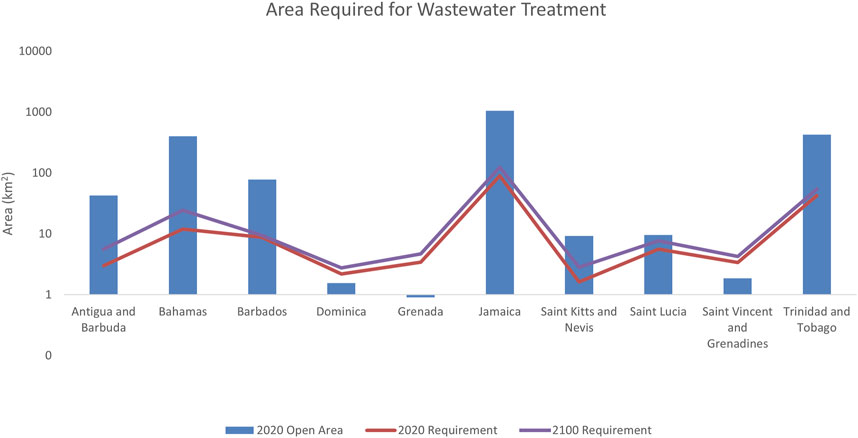
FIGURE 6. Required area to treat wastewater for each country. Population was multiplied by 0.379 m3/person/day to give produced wastewater, which was then divided by the ratio of 1 km2 to 12,500 m3/day to give the area required for treatment in km2.
The potential for treated water generated from constructed wetlands to supplement available water resources of each SIDS was evaluated for current resident population levels multiplied by 138 m3/capita/year wastewater generation and assuming 30% return of treated water to the resource base allowing for evapotranspiration losses (Figure 7). The potential replenishment of water resources in all SIDs was extremely low (mean 4%, range 1%–15%) and was only able to keep Antigua and Barbuda and St. Kitts and Nevis slightly above the absolute water scarcity threshold. Only when considering the massive seasonal population increase in many of the SIDS from tourists (Table 3) and associated disproportional increase in water demand does reuse of treated wastewater hold potential for increasing water resources availability.
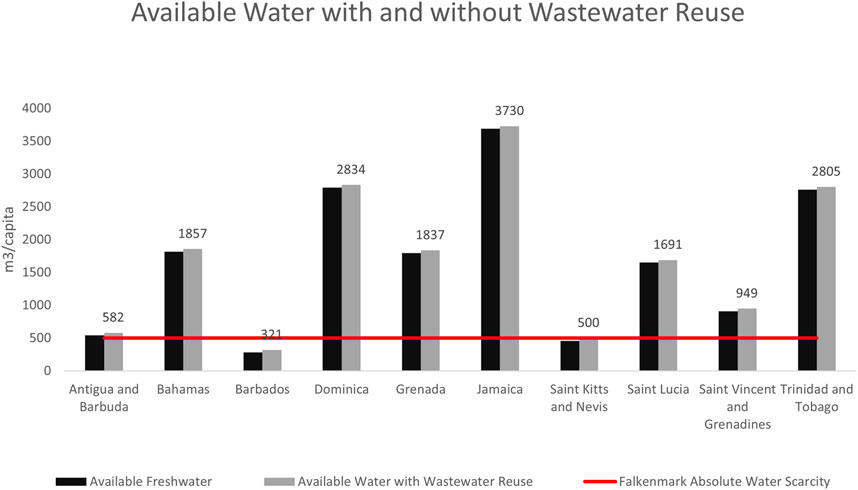
FIGURE 7. Available water for each SIDS utilizing wastewater reuse. The Falkenmark Absolute Water Scarcity constant (500 m3/capita) is graphed alongside annual renewable freshwater resources (m3/capita). Wastewater generated is a constant at 0.379 m3/capita/day. This was converted to 138 m3/capita/year, which was then decreased by 70% to account for evapotranspiration. This value was added to the annual renewable freshwater resources. Data compiled from the World Bank Database and Kadlec and Wallace (2009).
Populations and infrastructure are usually concentrated in low lying coastal areas of SIDS globally and are highly susceptible to inundation from sea level rise (UN-OHRLLS, 2013). Unlike coral islands of the Pacific, which are under imminent threat of total submersion, the average elevation of the Caribbean SIDS of this study ranges from 6 m (Bahamas) to 357 m (Dominica) (Figure 8). If undeveloped, open areas remain close to current extents on each island, the estimated range of sea level rise by 2100 (0.3–1.35 m) for the Caribbean basin (Strauss and Kulp, 2018) would reduce available land for nature-based solutions less than 1% for all SIDS, including the low lying Bahamas. Low lying areas of all SIDS, however, will face increased threats from storm surges and king tides, especially in the Bahamas, where 72% of the land area is below 5 m elevation. (UN-OHRLLS, 2013).
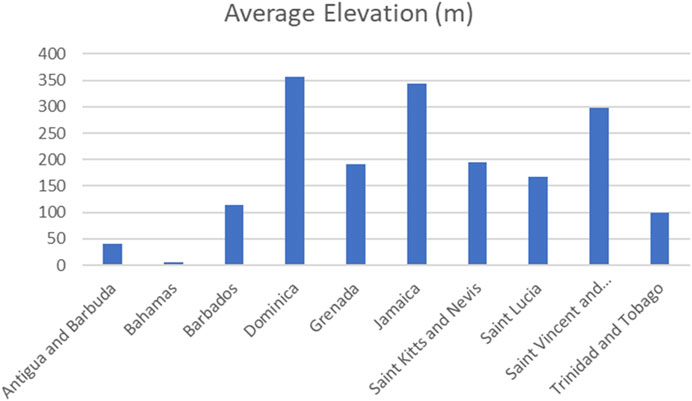
FIGURE 8. Average elevation in meters for each SIDS of this study. Data from the World Bank Database.
Since its inception in 2011, the WEF Nexus has been used increasingly as the preferred approach to predict societal and ecosystem sustainability via interactions among the three principal controlling variables: water, energy and food (Simpson and Jewitt, 2019). Most research has emphasized quantitative aspects of the WEF Nexus, but Castillo and Crisman (2019) stressed that wastewater generated from each sector has a profound impact on human health. Heal et al. (2020) stressed that both water quality and quantity are critical for facing the complex multidisciplinary challenges of WEF Nexus sustainability.
The ten SIDS of this study (Winters et al., 2022) and Puerto Rico (Crisman et al., 2021) currently fail all three components of the WEF Nexus. Both the environment and local communities in all displayed a great deal of resilience, but governance and economics clearly were not adapting to changing conditions and were a root cause of sustainability failure, as highlighted by Mycoo and Bharath (2021). In their literature review, Simpson and Jewitt (2019) identified both governance and the environment as key missing components of WEF Nexus assessments.
Isolation, small size, limited resources and vulnerability to natural hazards and climate change have profound implications for sustainability of SIDS populations and environments (Scandurra et al., 2018; Nel et al., 2021). Optimized use and reuse of existing water resources and identification of alternative water resources are key for sustainability of Caribbean SIDS (Figure 9). All three components of the WEF Nexus generate wastewater of differing quantity and quality that can be collected and treated with various nature-based solutions, especially constructed wetlands, and tailored to meet the conditions of each waste stream. Key to successful treatment is avoidance of centralized grey infrastructure and implementing treatment as close to waste source as possible.
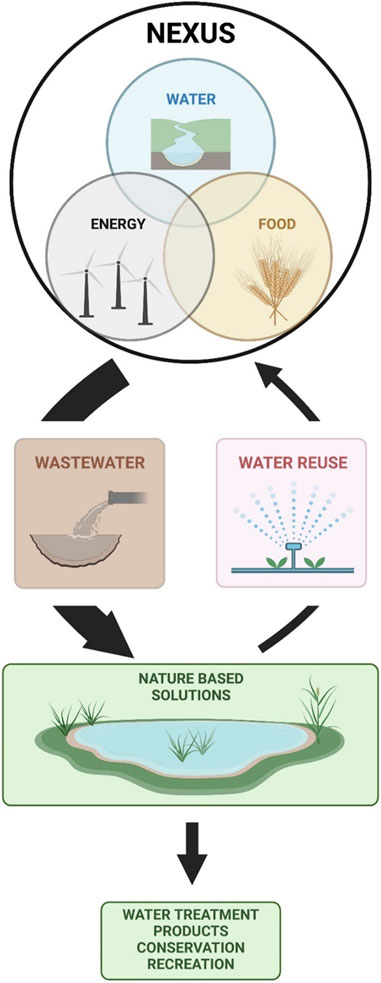
FIGURE 9. WEF Nexus model for long term sustainability recognizing wastewater as a potential water resource and nature-based technologies for water treatment and ecosystem services. Created with BioRender.com.
With infrastructure and populations concentrated in a narrow zone fringing the coast (Cashman and Nagdee, 2017; Pathak et al., 2021), all SIDS of this study appear to have sufficient open spaces to implement nature-based solutions until at least 2100 based on projected trends in resident populations. Future impacts from rapidly expanding tourist infrastructure and profound seasonal swelling of water resource demands and wastewater generation from tourists are likely to overwhelm any centralized water sources and wastewater treatment. Nature-based treatment options can be moved inland and tailored to meet unexpected and rapid changes in wastewater streams and should be keystone components for adaptative management plans for all Caribbean SIDS.
Treatment wetlands can be important areas for nature reserves and passive recreation (Castillo and Crisman, 2019). They are the linchpin to stop pollution of coastal resources and environmental from untreated wastewater. The near shore marine environments, including coral reefs, are facing serious problems throughout the Caribbean from bleaching and disease of coral, E. coli and total coliform contamination, elevated nutrients and contaminants and excessive growth of Sargassum and deposition nearshore (Siung-Chang, 1997; Lewsey et al., 2004; Patterson-Sutherland et al., 2010; Langin, 2018; Oviatt et al., 2019; Compton and Forde, 2020). All studies attribute these problems directly to unsustainable land use practices and discharge of raw sewage. The methodology discussed by Aide et al. (2020) provides an excellent model for incorporating native and functional species for wetland construction.
Tourism development depends on relatively intact and pristine ecosystems, but potential negative impacts on the environment from tourist activities can spell doom for the industry. Ali et al. (2018) and Mycoo (2006) stressed the critical need for sustainable ecosystem management of coastal areas of the Caribbean. Over 50% of coastal development will be lost with a 1 m of sea level rise (Scott et al., 2012), and 80% of tourists surveyed on Bonaire and Barbados stated an unwillingness to return if marine wildlife became degraded and beaches were lost from sea level rise (Uyarra et al., 2005). Sustainability practices currently implemented by the tourist industry are insufficient for environmental preservation, government intervention is needed to protect vulnerable ecosystems from tourist development (Gandoit, 2005; Charles, 2013; Mycoo, 2014).
All SIDS of this study suffer from unsustainable water resources for resident populations, and alternative water sources must be found. Although stormwater treatment wetlands are effective at capturing nutrients and many contaminants, their impact on microplastics and personal medications is unclear (Reyes et al., 2023). Still, van Houselt (2021) calculated that runoff from roads and stored in reservoirs could supply 45% of annual non-potable water demand in arid Curacao.
Rainwater harvest (RWH) brings people closer to the water source, thus encouraging water conservation and building societal resilience during climate extremes (Waite, 2012). RWH can be an essential water source for households in hilly terrain where connections to centralized systems are extremely difficult, and poor residents often spend 10% of their expendable income to meet household water demand (Waite, 2012; Rovira et al., 2020). The Grenadine islands have long relied on RWH and storage in cisterns for their water supply (Peters, 2013), and Aladenola et al. (2016) estimated that a storage tank of 2.5–4.0 m3 is sufficient to meet household needs during maximum dry season months in Jamaica. RWH currently meets 25% of household water needs in Jamaica and likely will meet 15% by 2080 after accounting for population demographics and climate change (Waite, 2012).
Development of communal RWH collection systems is often more efficient and innovative than household systems (Waite, 2012; Rovira et al., 2020). Stakeholders must take responsibility of financing, building and maintenance of RWH systems (Peters, 2016) in the absence of governmental guidelines for monitoring and maintaining systems throughout the Caribbean (Cashman and Carpenter, 2020). When implementing and expanding RWH however, it is imperative to understand and mitigate the potential negative health effects, such as growing mosquito populations, as highlighted by Moglia et al. (2016).
Tourism is two-edged sword for water sustainability in the Caribbean SIDS. Most economies promote expansion of the tourism industry despite unsustainable water demands from tourist inflated populations, especially during the dry season (Waite, 2012), and their distinct preference for high quality traditional water resources over desalinated water (Emmanuel and Spence, 2009). In Barbados, daily per capita water use by tourists is 3.6 times that of the resident population, and accounting of water demand by golf courses, cruise ships, seasonal expatriates, and short-term tourists is poorly documented (Emmanuel and Spence, 2009).
Tourist infrastructure has access to technology and funding to provide their guests with a quality and healthy experience. The demand for quantity and quality aspects of water will continue to grow as tourism increases its contribution to local economies. The key to sustainable water resources in Caribbean SIDS is a partnership between tourism development and residents to enhance water availability to local populations via potable water generation from tourism infrastructure and recycling of treated wastewater via nature-based solutions. Rather than increasing the burden on existing water resources, tourist development must develop desalination technologies and work to treat wastewaters from both their operations and local communities. Negative impacts on water quantity and quality on human consumption and the environment must be addressed by national policies developed through public-private consultation that incorporate adaptive management to address population dynamics, tourism and climate change.
The original contributions presented in the study are included in the article/Supplementary Materials, further inquiries can be directed to the corresponding author.
TC developed the scope and direction of the manuscript and wrote major sections of the manuscript. ZW performed data analysis and designed figures and tables for the manuscript. All authors contributed to the article and approved the submitted version.
The authors declare that the research was conducted in the absence of any commercial or financial relationships that could be construed as a potential conflict of interest.
All claims expressed in this article are solely those of the authors and do not necessarily represent those of their affiliated organizations, or those of the publisher, the editors and the reviewers. Any product that may be evaluated in this article, or claim that may be made by its manufacturer, is not guaranteed or endorsed by the publisher.
Adhikari, S., and Halden, R. U. (2022). Opportunities and limits of wastewater-based epidemiology for tracking global health and attainment of UN sustainable development goals. Environ. Int. 163, 107217. doi:10.1016/j.envint.2022.107217
Aide, M., Braden, I., Svenson, S., Siemers, S., and Murray, S. (2020). Employing constructed wetlands to sustainably manage nutrient-bearing water: A review with an emphasis on soil behavior and effluent nutrient reduction. J. Geoscience Environ. Prot. 8 (9), 94–106. doi:10.4236/gep.2020.89006
Aladenola, O., Cashman, A., and Brown, D. (2016). Impact of el niño and climate change on rainwater harvesting in a caribbean state. Water Resour. Manag. 30, 3459–3473. doi:10.1007/s11269-016-1362-2
Ali, S., Darsan, J., Singh, A., and Wilson, M. (2018). Sustainable coastal ecosystem management – An evolving paradigm and its application to caribbean SIDS. Ocean Coast. Manag. 168, 173–184. doi:10.1016/j.ocecoaman.2018.06.004
Bidlake, W. R., Woodham, W. M., and Lopez, M. A. (1996). Water-Supply Paper 2430. Washington, D.C: USGS.Evapotranspiration from areas of native vegetation in west-central Florida
Carvalho, P. N., Finger, D. C., Masi, F., Cipolletta, G., Oral, H. V., Toth, A., et al. (2022). Nature-based solutions addressing the water-energy-food nexus: Review of theoretical concepts and urban case studies. J. Clean. Prod. 338, 130652. doi:10.1016/j.jclepro.2022.130652
Cashman, A., and Carpenter, C. (2020). Rainwater harvesting water quality parameters relevant to the caribbean region: A short overview. Int. Public Health J. 12 (4), 349–355.
Cashman, A., and Nagdee, M. R. (2017). Impacts of climate change on settlements and infrastructure in the coastal and marine environments of the Caribbean Small Island Developing States (SIDS). Caribb. Mar. Clim. Change Rep. Card Sci. Rev. 2017, 155–173.
Cashman, A., Nurse, L., and John, C. (2010). Climate change in the caribbean: The water management implications. J. Environ. Dev. 19 (1), 42–67. doi:10.1177/1070496509347088
Castillo, R. M., and Crisman, T. L. (2019). The role of green infrastructure in water, energy, and food security in Latin America and the caribbean: Experiences, opportunities and challenges. Washington, D.C: Inter-American Development Bank. Discussion Paper IDB-DP 00693.
Chapman, I., Paul, D., Moise, G., and Riley, A. (2012). Wastewater production, treatment and use in St. Kitts. Proyecto de Desarrollo de Capacidades para el Uso Seguro de Aguas Servidas en Agricultura. FAO.
Charles, D. (2013). Sustainable tourism in the caribbean: The role of the accommodations sector. Int. J. Green Econ. 7 (2), 148–161. doi:10.1504/ijge.2013.057447
Compton, S., and Forde, M. (2020). Assessment of recreational water quality in the southern coastal areas of Grenada. Int. Public Health J. 12 (4), 393–403.
Corbi, C., Atis, M., Ebanks-Chin, A. C., García Cartagena, C. M., Mahabir, A., and Snyder, A. R. (2021). Nature-based solutions for wastewater management: Barriers and opportunities in the caribbean. United nations environment programme cartagena convention secretariat. Nat. Conservancy.
Crisman, T. L., Dumke, D., Rivera, F. I., and Santiago-Pimentel, L. (2021). Resilience of environment, infrastructure, communities and governance in Puerto Rico after Hurricane Maria and the need for community empowerment to develop decentralized, nature-based solutions to sustainability. J. Emerg. Manag. 19 (8), 11–23. doi:10.5055/jem.0608
Crisman, T. L., Dumke, D. T., and Winters, Z. S. (2022). Prepping for COP 27. The cairo review of global affairs. Winter 2022, 67–73.
Economic Commission for Latin America and Caribbean (2000). Port of Spain, Trinidad and Tobago.The vulnerability of the small island developing states of the Caribbean. ECLAC (United Nations). LC/CAR.G.588
Emmanuel, K., and Spence, B. (2009). Climate change implications for water resource management in Caribbean tourism. Worldw. Hosp. Tour. Themes 1 (3), 252–268. doi:10.1108/17554210910980594
Exner-Kittridge, M. G., and Rains, M. C. (2010). Case study on the accuracy and cost/effectiveness in simulating reference evapotranspiration in west-central Florida. J. Hydrologic Eng. 15 (9), 696–703. doi:10.1061/(asce)he.1943-5584.0000239
Falkenmark, M. (1989). The massive water scarcity now threatening Africa: Why isn’t it being addressed. Ambio 18, 112–118.
FAO (UN Food and Agriculture Organization) (2020). Aquastat - FAO's global information system on water and agriculture (accessed September 6, 2022).
Gohar, A. A., and Cashman, A. (2017). Change impacts on water scarcity and food security in tropical environments: the case of caribbean region. Int. J. Environ. Sci. Nat. Resour. Juniper Publishers Inc., 3 (2), 57–59. doi:10.19080/IJESNR.2017.03.555611
Gorgoglione, A., and Torretta, V. (2018). Sustainable management and successful application of constructed wetlands: A critical review. Sustainability 10, 3910. doi:10.3390/su10113910
Grandoit, J. (2005). Tourism as a development tool in the caribbean and the environmental by-products: The stresses on small island resources and viable remedies. J. Dev. Soc. Transformation 2, 89–97.
Hall, T. C., Sealy, A. M., Stephenson, T. S., Kusunoki, S., Taylor, M. A., Chen, A. A., et al. (2013). Future climate of the Caribbean from a super-high-resolution atmospheric general circulation model. Theor. Appl. Climatol. 113 (1-2), 271–287. doi:10.1007/s00704-012-0779-7
Heal, K. V., Bartosova, A., Hipsey, M. R., Chen, X., Buytaert, W., Li, H. Y., et al. (2020). Water quality: The missing dimension of water in the water-energy-food nexus. Hydrological Sci. J. 66 (5), 745–758. doi:10.1080/02626667.2020.1859114
Intergovernmental Panel on Climate Change (IPCC) (2022). Climate change 2022: Impacts, adaptation and vulnerability. Working group II contribution to the sixth assessment report of the IPCC. United Nations.
Island Water Technologies (IWT) (2016). Assessment of wastewater infrastructure and go-forward options for the village of Canaries. St. Lucia: Project Report.
Jacobs, J. M., Anderson, M. C., Friess, L. C., and Diak, G. R. (2004). Solar radiation, longwave radiation and emergent wetland evapotranspiration estimates from satellite data in Florida, USA. Hydrol. Sci. 49 (3), 461–476. doi:10.1623/hysj.49.3.461.54352
Jordan, D. G., and Fisher, D. W. (1977). Geological survey water-supply paper 1663-1. Washington, D.C: USGS.Relation of bulk precipitation and evapotranspiration to water quality and water resources, St. Thomas, Virgin Islands
Langin, K. (2018). Seaweed masses assault Caribbean islands. Science 360 (6394), 1157–1158. doi:10.1126/science.360.6394.1157
Lewsey, C., Cid, G., and Kruse, E. (2004). Assessing climate change impacts on coastal infrastructure in the Eastern Caribbean. Mar. Policy 28, 393–409. doi:10.1016/j.marpol.2003.10.016
Masi, F., Hamouri, B. E., Abdel Shafi, H., Baban, A., Ghrabi, A., and Regelsberger, M. (2010). Treatment of segregated black/grey domestic wastewater using constructed wetlands in the mediterranean basin: The zer0-m experience. Water Sci. Technol. 61 (1), 97–105. doi:10.2166/wst.2010.780
Moglia, M., Gan, K., and Delbridge, N. (2016). Exploring methods to minimize the risk of mosquitoes in rainwater harvesting systems. J. Hydology 543, 324–329. doi:10.1016/j.jhydrol.2016.10.010
Mycoo, M. A., and Bharath, K. (2021). Sustainable development goal 11 and a new urban agenda for caribbean small island developing states: Policy, practice, and action. Front. Sustain. Cities, 3.
Mycoo, M. A., Griffith-Charles, C., and Lalloo, S. (2015). Land management and environmental change in small-island-developing states: The case of St. Lucia. Reg. Environ. Change, 17:1065–1076. doi:10.1007/s10113-016-1050-z
Mycoo, M. (2006). Sustainable tourism using regulations market mechanisms and green certification: A case study of Barbados. J. Sustain. Tour. 15 (5), 489–511. doi:10.2167/jost600.0
Mycoo, M. (2014). Sustainable Tourism, climate change and sea level rise adaptation policies in Barbados. Nat. Resour. Forum 38, 47–57. doi:10.1111/1477-8947.12033
Nel, R., Mearns, K. F., Jordaan, M., and Goethals, P. (2021). Towards understanding the role of islandness in shaping socio-ecological systems on SIDS: The socio-ecological islandscape concept. Ecol. Inf. 62, 101264. doi:10.1016/j.ecoinf.2021.101264
Oviatt, C. A., Huizenga, K., Rogers, C. S., and Miller, W. J. (2019). What nutrient sources support anomalous growth and the recent sargassum mass stranding on caribbean beaches? A review. Mar. Pollut. Bull. 145, 517–525. doi:10.1016/j.marpolbul.2019.06.049
Pandey, D., Gupta, A., and Anderson, D. (2003). Rainwater harvesting as an adaptation to climate change. Curr. Sci. 85 (1), 46–59.
Pathak, A., van Beynen, P. E., Akiwumi, F. A., and Lindeman, K. C. (2021). Impacts of climate change on the tourism sector of a small island developing state: A case study for the Bahamas. Environ. Dev. 37, 100556. doi:10.1016/j.envdev.2020.100556
Peters, E. J. (2013). “Promoting rainwater harvesting (RWH) in small island developing states (SIDS): A case in the Grenadines,” in Cases on the diffusion and adoption of sustainable development practices. Editors H. Muga, and K. Thomas (Hershey, PA: IGI Global), 403–438.
Peters, E. J. (2016). Success and success factors of domestic rainwater harvesting projects in the Caribbean. J. Sustain. Dev. 9 (5), 55–69. doi:10.5539/jsd.v9n5p55
Peters, E. J. (2015). Wastewater reuse in the eastern caribbean: A case study. Water Manag. 168 (5), 232–242. doi:10.1680/jwama.14.00059
H. O. Portner, D. C. Roberts, M. Tignor, E. S. Poloczanska, K. Mitenbeck, A. Alegriaet al. (Editors) (2022). Climate change 2022: Impacts, adaptation and vulnerability. Contribution of working group II to the sixth assessment report of the intergovernmental panel on climate change (Cambridge, UK: Cambridge University Press).
Reyes, N. J. D. G., Geronimo, F. K. F., Guerra, H. B., and Kim, L.-H. (2023). Bibliometric analysis and comprehensive review of stormwater treatment wetlands: Global research trends and existing knowledge gaps. Sustainability 15, 2332. doi:10.3390/su15032332
Rodriguez-Dominguez, M. A., Konnerup, D., Brix, H., and Arias, C. A. (2020). Constructed wetlands in Latin America and the caribbean: A review of experiences during the last decade. Water 12, 1744. doi:10.3390/w12061744
Rovira, C., Sanchez-Masferrer, M., and Rovira, M. D. (2020). Is rainwater harvesting a solution for water access in Latin America and the caribbean ? An economic analysis for underserved households in El Salvador. Technical note IDB-TN-1679. Washington, D.C: InterAmerican Development Bank.
Scandurra, G., Romano, A. A., Ronghi, M., and Carfora, A. (2018). On the vulnerability of small island developing states: A dynamic analysis. Ecol. Indic. 84, 382–392. doi:10.1016/j.ecolind.2017.09.016
Scott, D., Simpson, M. C., and Sim, R. (2012). The vulnerability of Caribbean coastal tourism to scenarios of climate change related sea level rise. J. Sustain. Tour. 20 (6), 883–898. doi:10.1080/09669582.2012.699063
Simpson, G. B., and Jewitt, G. P. (2019). The development of the water-energy-food nexus as a framework for achieving resource security: A review. Front. Environ. Sci. 7, 8. doi:10.3389/fenvs.2019.00008
Siung-Chang, A. (1997). A review of marine pollution issues in the Caribbean. Environ. Geochem. Health 19, 45–55. doi:10.1023/a:1018438119034
Strauss, B., and Kulp, S. (2018). Sea-Level Rise Threats in the Caribbean: Data, tools, and analysis for a more resilient future. Washington, D.C: Inter-American Development Bank.
Sutherland, K. P., Porter, J. W., Turner, J. W., Thomas, B. J., Looney, E. E., Luna, T. P., et al. (2010). Human sewage identified as likely source of white pox disease of the threatened Caribbean elkhorn coral, Acropora palmata. Environ. Microbiol. 12 (5), 1122–1131. doi:10.1111/j.1462-2920.2010.02152.x
United Nations Conference on Trade and Development (2021). “If SIDS were a country,” in Development and globalization: Facts and figures 2021. Available online: https://dgff2021.unctad.org/if-sids-were-a-country/(accessed on October 18, 2021).
United Nations Environment Programme (1999). Report of the workshop on tourism and sustainable development in the mediterranean. Athens: United Nations Environment Programme. MAP Technical Reports Series No. 126.
United Nations Office of the High Representative for the Least Developed Countries, Landlocked Developing Countries and Small Island Developing States (2013). Small island developing States in numbers. New York: United Nations.
United Nations (1993). Report of the united nations conference on environment and development, rio de Janeiro, Brazil, 3-14 june 1992. Volume I: Resolutions adopted by the conference. New York: United Nations.
United Nations (2019). Small island developing States. United Nations. Available online: https://sustainabledevelopment.un.org/topics/sids (accessed on September 25, 2019).
Uyarra, M. C., Cote, I. M., Gill, J. A., Tinch, R. R., Viner, D., and Watkinson, A. R. (2005). Island-specific preferences of tourists for environmental features: Implications of climate change for tourism-dependent states. Environ. Conserv. 32 (1), 11–19. doi:10.1017/s0376892904001808
Valero, S., Miranda, J. J., and Murisic, M. (2021). Nature-based solutions for improving resilience in the Caribbean. Washington, D.C: The World Bank and the Global Facility for Disaster Reduction and Recovery.
van Houselt, G. J. (2021). MS thesis. Netherlands: Utrecht University.A rainwater harvesting system based blueprint for excess runoff management on Caribbean small island developing states
Waite, M. (2012). Climate-change mitigation and adaptation in small island developing states: The case of rainwater harvesting in Jamaica. Sustain. Sci. Pract. Policy 8 (2), 81–87. doi:10.1080/15487733.2012.11908101
Keywords: caribbean, SIDS, nexus, sustainability, nature-based solutions
Citation: Crisman TL and Winters ZS (2023) Caribbean small island developing states must incorporate water quality and quantity in adaptive management of the water-energy-food nexus. Front. Environ. Sci. 11:1212552. doi: 10.3389/fenvs.2023.1212552
Received: 26 April 2023; Accepted: 31 July 2023;
Published: 10 August 2023.
Edited by:
Lynn Donelson Wright, College of William & Mary, United StatesReviewed by:
Kathleen Sullivan Sealey, University of Miami, United StatesCopyright © 2023 Crisman and Winters. This is an open-access article distributed under the terms of the Creative Commons Attribution License (CC BY). The use, distribution or reproduction in other forums is permitted, provided the original author(s) and the copyright owner(s) are credited and that the original publication in this journal is cited, in accordance with accepted academic practice. No use, distribution or reproduction is permitted which does not comply with these terms.
*Correspondence: Thomas L. Crisman, dGNyaXNtYW5AdXNmLmVkdQ==
Disclaimer: All claims expressed in this article are solely those of the authors and do not necessarily represent those of their affiliated organizations, or those of the publisher, the editors and the reviewers. Any product that may be evaluated in this article or claim that may be made by its manufacturer is not guaranteed or endorsed by the publisher.
Research integrity at Frontiers

Learn more about the work of our research integrity team to safeguard the quality of each article we publish.